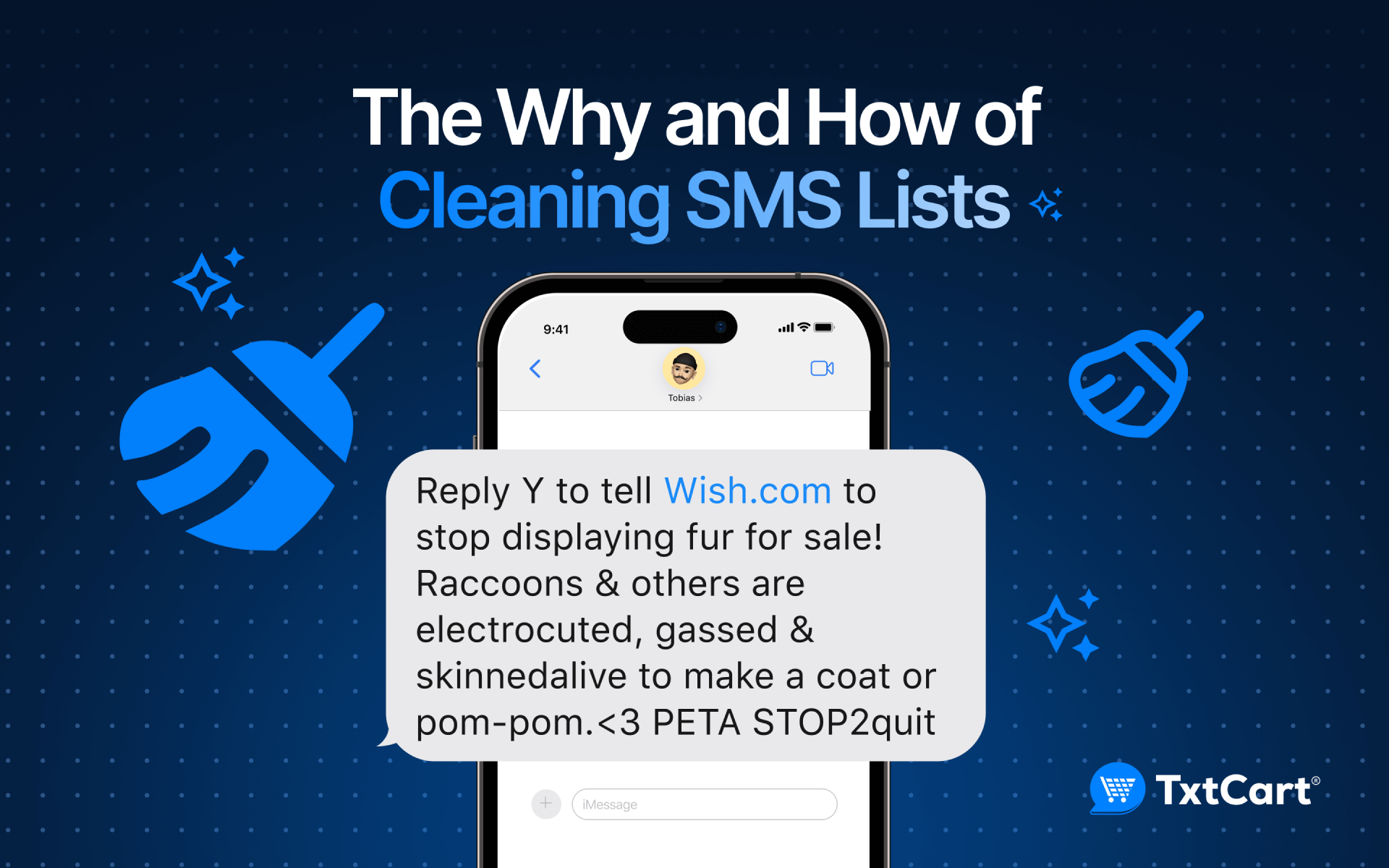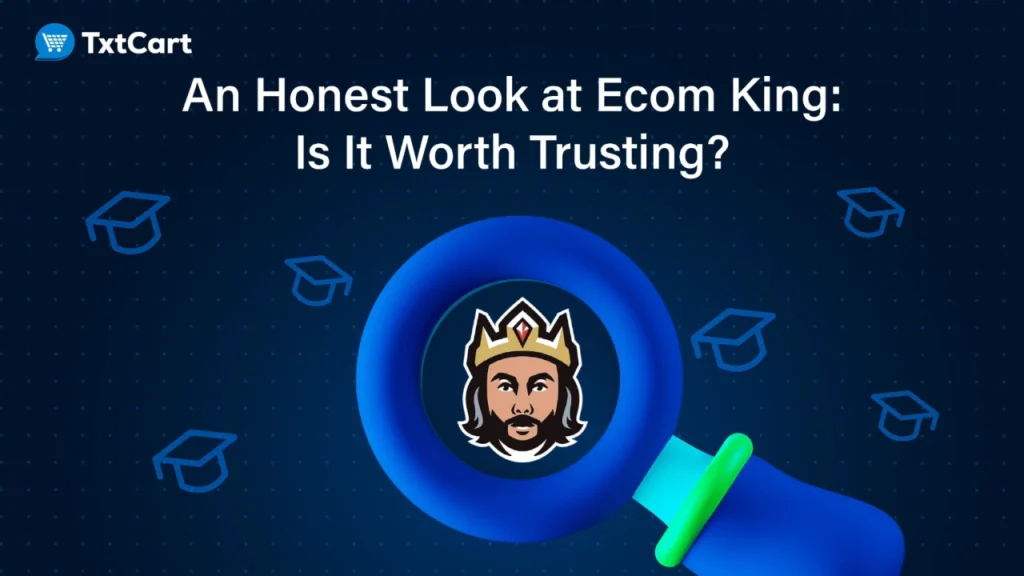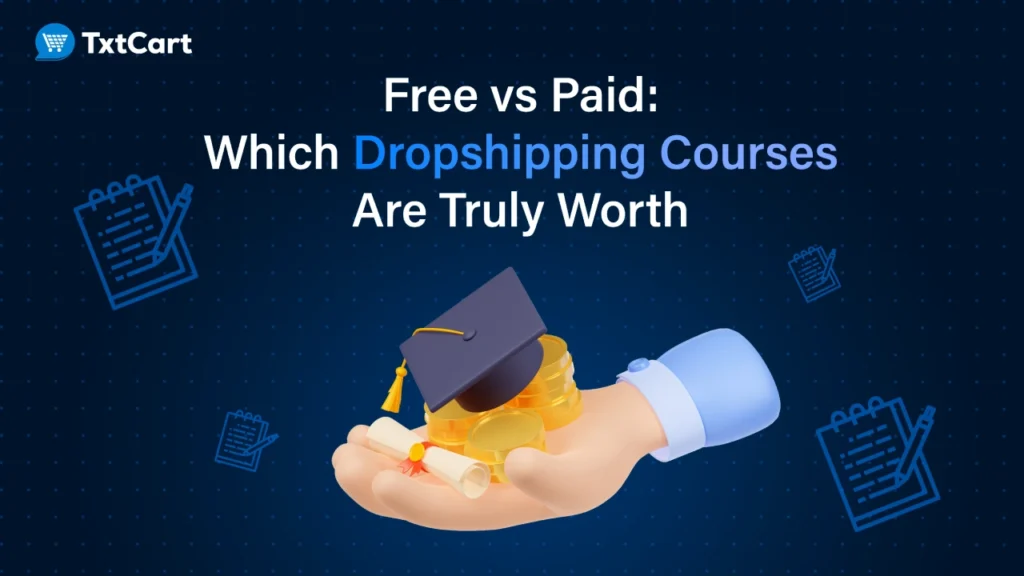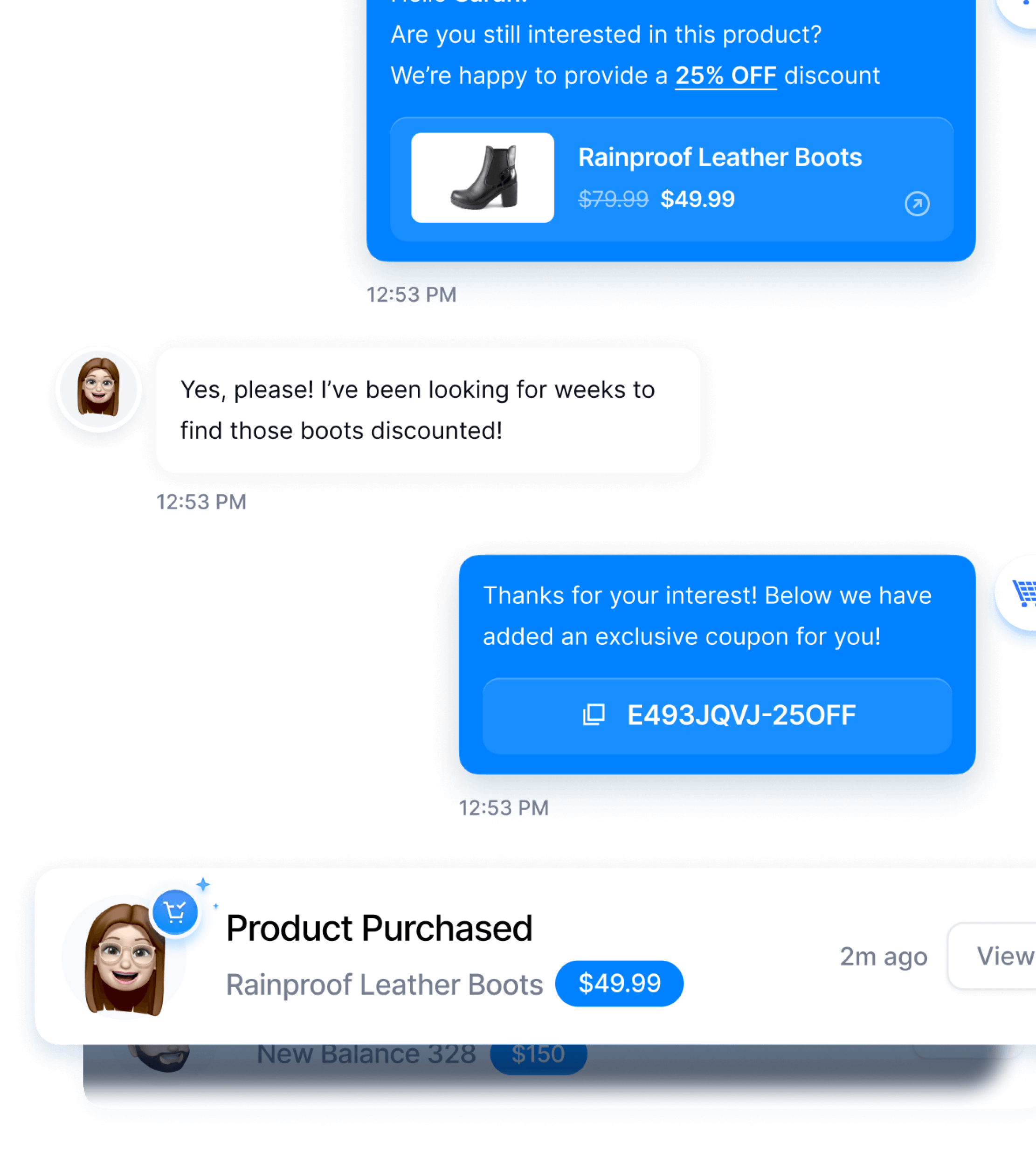What if your SMS campaigns aren’t underperforming because of the message—but because of who you’re sending them to? A cluttered SMS list filled with outdated contacts, invalid numbers, and opt-outs can quietly drain your budget, hurt deliverability, and kill engagement. The good news? A clean list could be your hidden growth lever.
In this article, we’ll cover:
- Why SMS list cleaning is important
- How to identify and remove invalid numbers, opt-outs, and spam traps
- Strategies to clean your SMS list and boost campaign performance
So, let’s get started!
TL;DR
- Implement a double opt-in system that sends a confirmation message requiring action before adding numbers to your marketing list
- Set up automated compliance checks that cross-reference new subscribers against the Do Not Call Registry and honor quiet hours based on time zones
- Connect your Shopify checkout data with your SMS platform to automatically update customer information and remove outdated contacts
- Create a 60-day inactivity segment to identify and either remove or target disengaged subscribers with re-engagement campaigns
- Establish a separate “unsubscribed” database that prevents accidental re-addition while preserving customer history
- Use phone number validation tools that verify carrier information and number formatting before sending your first message
- Set up automated bounce tracking to immediately flag and remove numbers that consistently fail delivery attempts
Why SMS List Cleaning Could Be the Best Marketing Move You’re Not Making
The truth is, even the most brilliant SMS marketing campaign won’t work if it’s being sent to the wrong people or worse, to dead numbers that never respond. Cleaning your SMS list isn’t just about being organized; it’s about unlocking real results from the messages you’re already sending.
Let’s break down why this matters more than you might think:
- Improved deliverability: Your text messages actually land in the inboxes of real customers, not lost in limbo with invalid numbers.
- Smarter spending: Why pay to send messages to people who can’t receive them? A clean list saves money by cutting out unreachable contacts.
- Higher engagement rates: When your list is full of people who actually want to hear from you, your open and click-through rates go way up.
- Better reputation with carriers: Consistently sending to valid, engaged subscribers helps you avoid being flagged as spam, which means more of your messages get delivered.
- Stay on the right side of the law: Keeping your SMS list clean helps ensure you’re following SMS regulations like TCPA, which protects both your business and your subscribers.
Cleaning your SMS list isn’t just a “nice to have”—it’s one of the smartest things you can do to drive more sales, more engagement, and a better return on every message you send.
Now, let’s go over who the unhealthy and healthy subscribers are.
Healthy vs. Unhealthy SMS Subscribers: Who’s Really On Your List?
Not every subscriber is worth keeping. Understanding the difference between engaged and disengaged contacts is the first step to a healthier, high-performing SMS list.
| Healthy SMS Subscribers | Unhealthy SMS Subscribers |
|---|---|
| Actively engage with your SMS campaigns | Subscribed once but no longer interact |
| Explicitly opted in to your SMS list | No longer see value in your messages |
| Have valid, active phone numbers | Don’t engage with any of your SMS campaigns |
| Can be segmented by level of engagement (active, passive, occasional) | May have signed up long ago, but are now disengaged |
Now that you know who you’re looking at in your SMS subscribers list, let’s move to how you should be cleaning your SMS list.
Shopify Store SMS List Cleaning Methods
Cleaning your SMS list isn’t just a one-time fix—it’s a routine that keeps your campaigns lean, legal, and laser-focused. Whether you’re prepping for your next big sale or just trying to boost customer engagement, these methods will help you keep your subscriber list fresh and effective.
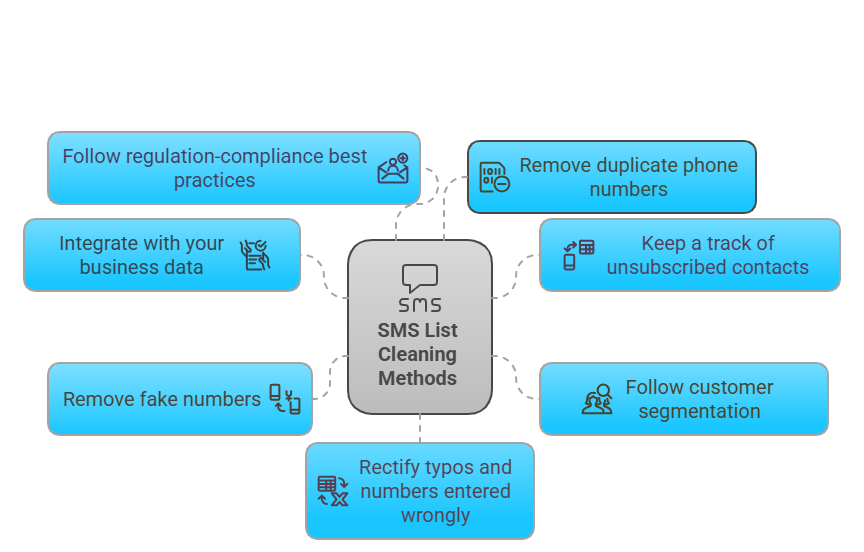
1. Follow regulation-compliance best practices
Just because someone bought from you or gave you their phone number doesn’t mean they’ve agreed to receive marketing messages. That’s where SMS regulations come in, and ignoring them can cost you big.
Here’s what to keep in mind:
- Explicit opt-ins are a must before sending promotional messages. No shortcuts.
- Different countries, different rules. If you’re running a global Shopify store, make sure you’re following the right regulations based on where your subscribers live—like TCPA for the U.S., GDPR for the EU, and CASL for Canada.
- Buying SMS lists is a no-go. You have no way of knowing if those contacts were collected compliantly, and messaging them could damage your sender’s reputation or even get you fined.
💡 Pro tip: Staying TCPA-compliant doesn’t have to be complicated. Platforms like TxtCart automate key compliance tasks—like managing opt-outs, honoring quiet hours, and cross-referencing the Do Not Call Registry—so you can focus on growth, not legal headaches.
Read Next:
- All you could know about SMS Marketing Compliance for Shopify
- Complete Guide to SMS Marketing Compliance
- The Ultimate Guide to SMS Opt-in for 2025 (Tips + Examples)
2. Integrate with your business data
Got contact numbers scattered across different tools, teams, or spreadsheets? You’re not alone. But if your SMS list lives in a silo, you’re missing out on cleaner, smarter, more efficient messaging.
When you integrate your SMS platform with the rest of your business data—like your CRM, checkout system, or customer support tools—you unlock two major benefits:
- Your SMS list updates automatically with new phone numbers as customers come in.
- You can remove duplicates and outdated contacts without doing it all manually.
The result? A more accurate, up-to-date SMS list that’s lean, relevant, and ready for action.
Read Next: 11 Best eCommerce Integrations for Your Online Store in 2025
3. Follow customer segmentation
Not all subscribers want the same thing—so why send them the same message? Segmenting your SMS list lets you group contacts based on:
- Age
- Gender
- Interests
- Geographic location
- Behavior
- Purchase history
- Engagement levels
Segmentation makes it easier to keep your lists clean, relevant, and up-to-date. It helps you identify disengaged subscribers, remove or re-engage them strategically, and avoid sending messages to people who no longer interact.
Plus, segmentation helps you spot patterns and problems. If a certain segment starts dropping off, you can quickly identify the issue and take action, like running a win-back SMS campaign tailored to that group.
Here’s a quick look at how you can use segmentation in action:
| Segment Type | How to Segment | What to Send (SMS Example) |
|---|---|---|
| New Subscribers | Joined in the last 7 days | “Hey [Name]! Thanks for joining. Here’s 10% off your first order 🎉” |
| Frequent Buyers | Made 3+ purchases in the last 30 days | “You’re one of our VIPs! Enjoy free shipping on your next order 🚚” |
| Abandoned Cart | Added to cart but didn’t check out | “Still thinking it over? Your cart’s waiting – grab it before it’s gone!” |
| Inactive Subscribers | No interaction in the last 60+ days | “We miss you! Here’s 15% off to say hi again 😊” |
| High-Intent Shoppers | Clicked links but didn’t convert | “Looks like you’re eyeing something! Need help deciding?” |
| Location-Based | Based on city, region, or country | “Flash sale only for LA shoppers! 20% off today only 🛍️” |
💡 Pro tip: TxtCart’s smart customer segmentation lets you target audiences by purchase behavior, cart activity, and engagement levels—so you can send better messages and spot unengaged contacts to re-engage or remove. The result? A cleaner, more effective SMS list.
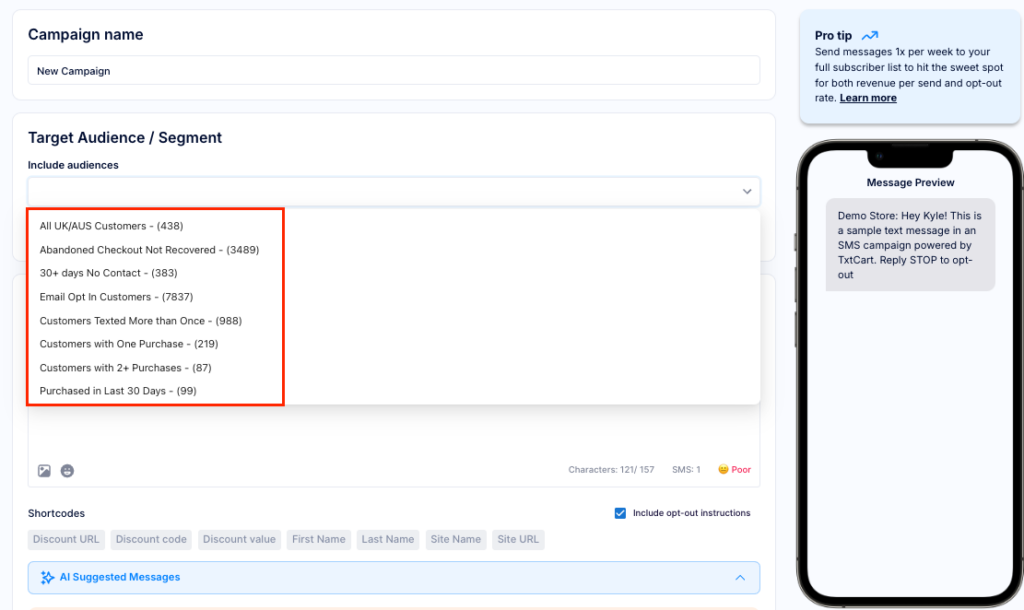
Read Next: What is SMS Segmentation, Best Practices & Examples
4. Remove duplicate phone numbers
Duplicate numbers often sneak in when you merge lists or when someone signs up more than once. When the same person gets the same message multiple times, it’s not just annoying, it can actually hurt your engagement. They may start ignoring your texts altogether, or worse, opt out completely. And from your end, it skews your campaign performance with inflated costs and lower open rates.
Cleaning out duplicates keeps your messages targeted and your list tidy. You can do this by regularly scanning your contact list for repeated phone numbers, especially after importing or merging lists.
💡 Pro Tip: Use tools that offer a built-in duplication feature that automatically detects and removes duplicates before a campaign goes out, saving you time and avoiding those awkward double-sends.
5. Keep track of your unsubscribed contacts
Just like with email, SMS subscribers can opt out of your messages anytime, and they will, especially if they’re no longer interested. That’s why many brands include an unsubscribe link or reply option in every SMS they send.
It’s crucial to regularly monitor these unsubscribed contacts and ensure they’re removed from your active SMS list. Continuing to message them not only hurts your sender reputation, but it can also land you in hot water with SMS regulations.
That said, you don’t have to delete them entirely. You can maintain a separate “cold” list of unsubscribers for future re-engagement—maybe through email or exclusive win-back offers—but only if it’s compliant and respectful of their preferences.
6. Remove fake numbers
Shoppers entering fake or incorrect phone numbers is a surprisingly common problem. Rather than refusing to share their contact info, some people just type in random digits to move forward with checkout or access a promo.
The result? Your SMS messages either go to the wrong person or to no one at all. This drags down your open and response rates, wastes your budget, and clutters your list with useless contacts.
Here’s how you can detect fake SMS numbers:
| Step | What to Do |
|---|---|
| 1. Send a confirmation SMS | Immediately send a welcome or opt-in confirmation. This helps filter out invalid or unreachable numbers right away |
| 2. Monitor delivery reports | Track failed deliveries or bounce rates. Failed messages often indicate fake or inactive numbers |
| 3. Use phone number validation | Cross-check number formats and carriers. This helps catch incorrect formatting or non-existent numbers |
| 4. Check engagement over time | Flag contacts with zero interaction for 30+ days. Fake or unengaged numbers dilute engagement rates |
| 5. Avoid manual imports from untrusted sources | Only use verified sources or forms with double opt-in. This helps reduce the risk of spammy or fake numbers entering your list |
7. Rectify typos and incorrectly entered numbers
Your SMS list may contain phone numbers that were entered incorrectly, like missing a plus sign, swapping a zero for the letter ‘O’, or even inputting the wrong country code. These small typos can cause your messages to bounce or go undelivered.
Regularly checking and correcting these errors helps keep your contact list clean and your SMS deliverability high. Again, the subscription confirmation message can act as a built-in check, helping you catch invalid numbers early.
How Often Should You Clean Your SMS List?
If you send texts daily, clean monthly. For weekly or monthly sends, clean every 6–12 weeks. Moreover, always clean your list before major campaigns to remove inactive, bounced, or unsubscribed contacts and improve engagement rates.
SMS list cleaning frequency workflow:
| Message Frequency | Cleaning Frequency | Why |
|---|---|---|
| Daily SMS sends | Every 4 weeks (Monthly) | High volume = faster data decay and higher bounce/unsubscribe rates |
| Weekly campaigns | Every 6–8 weeks | Keeps the list responsive and avoids engagement drop |
| Bi-weekly or monthly sends | Every 2–3 months | Enough time to gather engagement data, while keeping the list fresh |
| Seasonal/occasional promos | Before every major campaign | Avoid wasting SMS credits on invalid or cold numbers |
| High bounce or opt-out rates | Immediately (audit and clean) | Protects sender reputation and improves deliverability |
How to Grow Your SMS List (With Quality Subscribers That Actually Engage)
Cleaning your SMS list is essential, but so is growing it with the right subscribers. Instead of chasing numbers, focus on building a list of people who genuinely want to hear from you.
Here are some powerful, proven ways to do that:
1. Offer SMS-exclusive discounts
One of the best ways to encourage people to subscribe is by offering exclusive discounts or deals in exchange for their phone number. These should be offers they can’t get anywhere else—only through SMS.
Here’s how to make it work:
- Create a compelling SMS-only offer that gives real value, like “Get 10% off your first order when you sign up for SMS updates.”
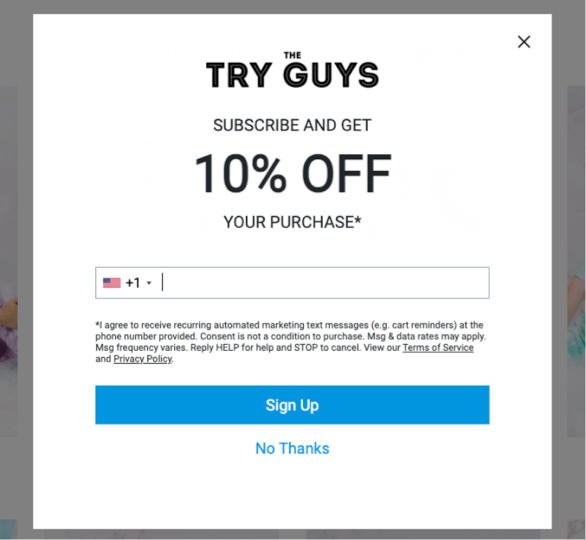
- Promote this SMS-only offer across your marketing channels—your website (via pop-ups or banners), social media posts, email newsletters, and even during checkout.
- Keep the opt-in process simple—use a short form, ideally mobile-friendly, and clearly state what users will receive.
- Send the discount via SMS immediately after they opt in. This builds trust and encourages first-time purchases.
Read Next: 11 Types of Discounts to Use in SMS Marketing Campaigns to Drive More Sales
2. Use shortcodes to make opt-ins effortless
Ever seen messages like “Text SAVE10 to 45454 to unlock your discount”? That five-digit number is called a shortcode, and it’s one of the easiest ways to grow your SMS list quickly, especially during high-traffic moments like sales or product launches.
Shortcodes simplify the opt-in process. Shoppers don’t need to fill out a form or click a link—they just send a quick text, and boom—they’re subscribed.
Here’s how to use shortcodes effectively:
- Create a keyword + shortcode combo that’s easy to remember (e.g., “Text DEAL to 45454”).
- Promote it everywhere—on packaging, in-store signage, social media, email campaigns, and website banners.
- Tie it to a clear incentive like a discount, early access, or a chance to win something valuable.
- Use it beyond signups—shortcodes can also be used to share OTPs, send flash sale alerts, or even collect quick feedback via SMS.
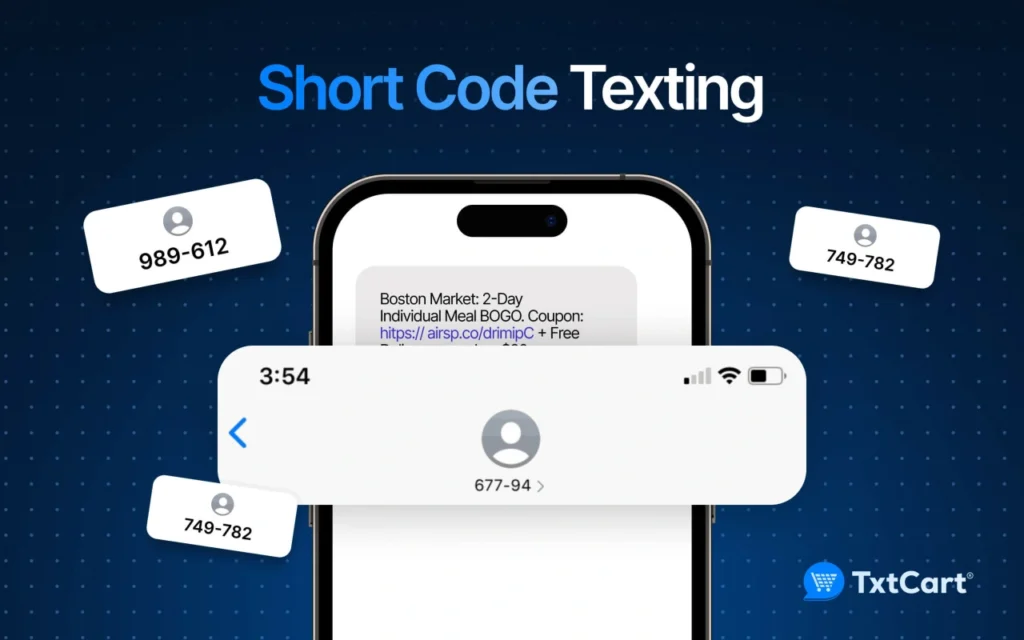
Read Next: SMS Short Code Guide: What is Short Code Texting and Best Practices
3. Use pop-ups to collect phone numbers (Without being annoying)
Pop-ups have a high success rate when they’re done right. Whether it’s a discount, early access, or a freebie, a well-timed pop-up can help turn casual browsers into subscribers who actually want to hear from you.
Here’s how to make SMS opt-in pop-ups work:
- Time it right – Show the pop-up after a few seconds, when someone scrolls down, or just before they exit.
- Offer something enticing – Think: “Get 10% off via text” or “Sign up for SMS and be the first to hear about drops.”
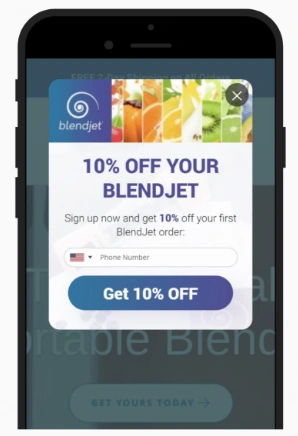
- Keep it simple – Ask only for their phone number (and maybe name). Fewer fields = more signups.
- Make it personal – Tailor your message according to the types of visitors, e.g. first-time visitors, returning shoppers etc.
| Visitor Type | Personalized Message Example |
|---|---|
| First-time visitors | “Welcome! Get 10% off your first order—sign up for SMS updates now 📱” |
| Returning visitors | “Hey, good to see you again! Want early access to our next drop? Join our SMS list.” |
| Cart abandoners | “Still thinking it over? Sign up for SMS and we’ll send you a special deal 💬” |
| Loyal customers | “You’re one of our VIPs! Get exclusive updates and offers via text 💎” |
BTW, whether you’re looking to send basic personalized SMS or texts that feel like they’re coming from a real person, TxtCart gives you the tools you need—customer data, behavior insights, and powerful conversational AI. This combo lets you craft hyper-personalized and targeted texts that sell like crazy!
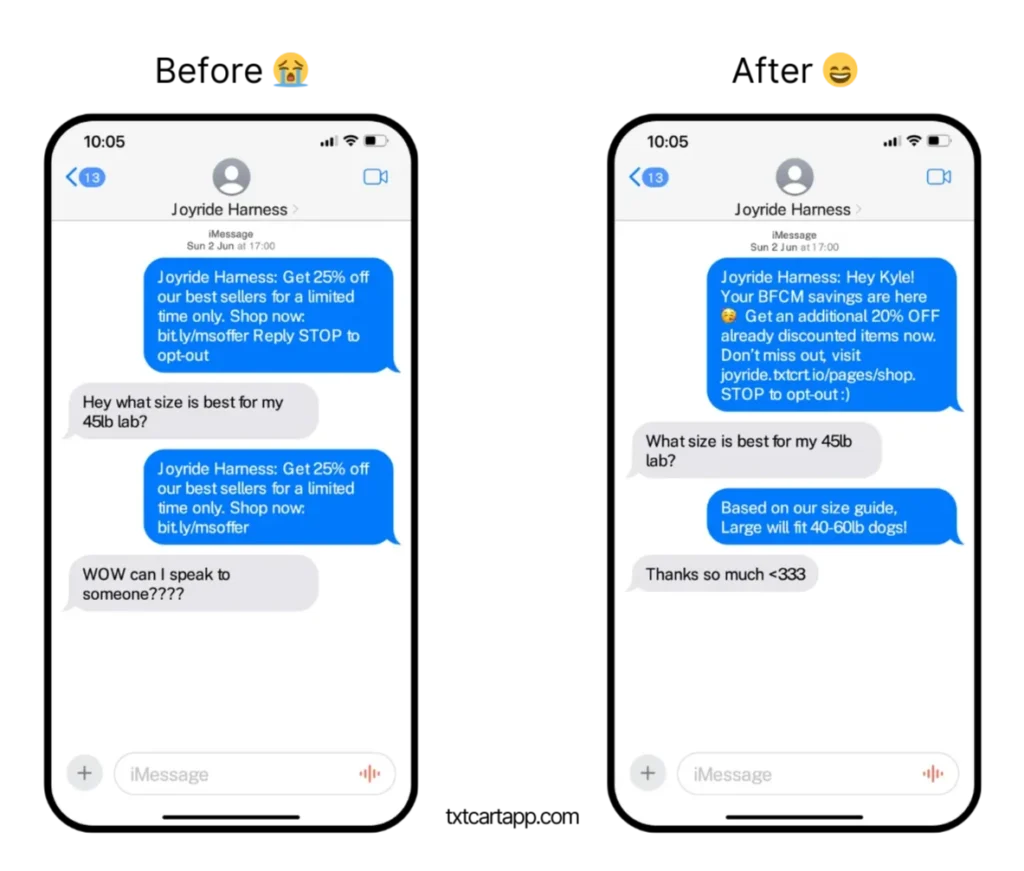
Read Next:
4. Use email campaigns to grow your SMS list
Already have a strong email list? Great—that’s your best starting point for growing a high-quality SMS list. These subscribers already know and like your brand, which makes them far more likely to say “yes” to texts too. The key is to position SMS as an exclusive upgrade, not just another way to communicate.
How to turn email subscribers into SMS subscribers:
- Run a dedicated SMS opt-in email campaign with a clear value offer (e.g., “Get early access to sales via text” or “Join our VIP SMS list for exclusive deals”).
- Add SMS sign-up CTAs to your regular newsletters, especially around launches or sales.
- Create a special offer for email subscribers who opt into SMS—think stackable discounts, free shipping, or first dibs on new drops.
- Highlight the benefits of SMS over email: it’s instant, more personal, and perfect for time-sensitive offers.
5. Collect SMS subscribers from out-of-stock products
Sold-out products don’t have to mean lost sales—they can actually be a smart opportunity to grow your SMS list with high-intent shoppers. When something goes out of stock, offer customers the chance to sign up for back-in-stock alerts via SMS.
This way, you’re not just building your list—you’re collecting numbers from people who are ready to buy.
How to make it work:
- Add a “Notify Me via SMS” button to out-of-stock product pages.
- Let customers know they’ll get first dibs as soon as the product is restocked.
- Use clear messaging that sets expectations: “We’ll text you the moment it’s available again.”
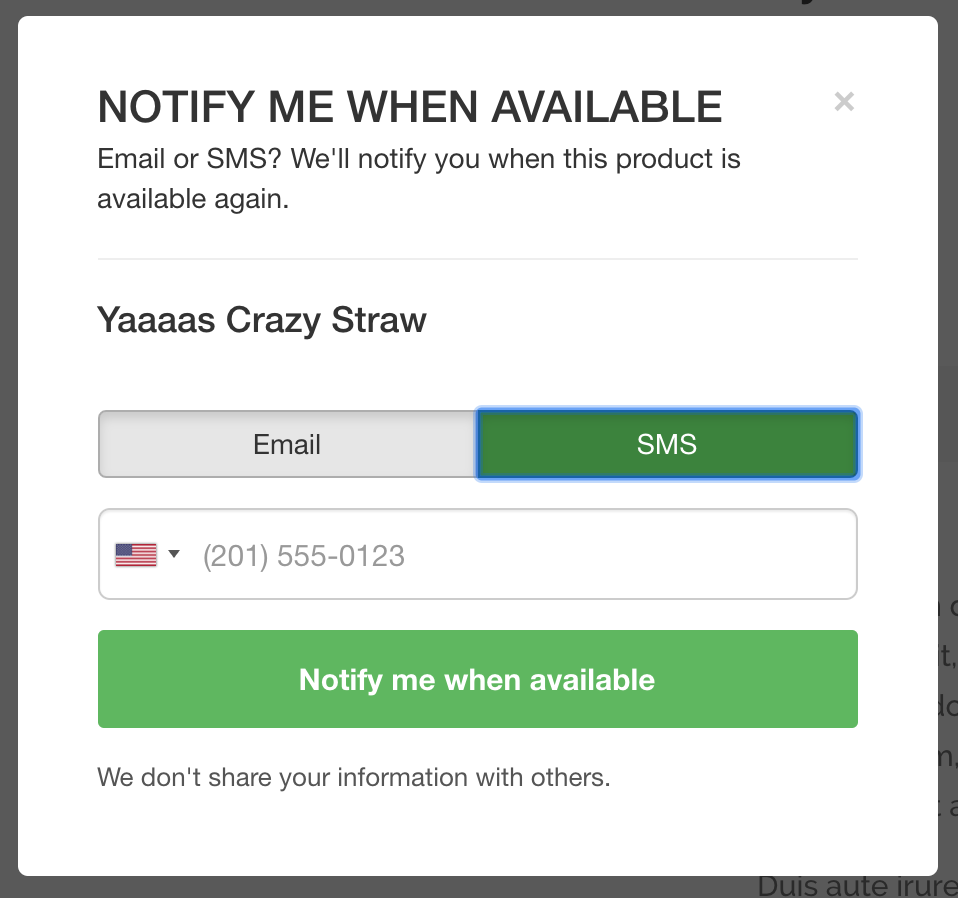
6. Grow your SMS list through referrals
Your loyal customers aren’t just repeat buyers—they can also be your best promoters. When someone refers a brand to a friend, that recommendation carries more trust than any ad ever could. You can use this built-in trust to grow your SMS list organically.
How to do it:
- Create a simple “Refer-a-Friend” SMS program where existing subscribers can invite friends by sharing a referral link or submitting their phone number (with permission).
- Offer incentives for both parties—like discounts, loyalty points, or exclusive offers—for every successful referral.
- Promote this referral opportunity via SMS, email, and post-purchase pages to your most engaged customers.
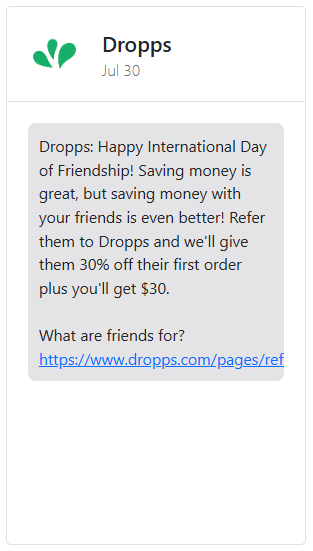
Best Practices to Keep Your Shopify Store SMS List Healthy
Keeping your SMS list clean is an ongoing strategy. Here are best practices grouped into three key areas to help you maintain a high-performing, compliant, and engaged SMS subscriber base:
Collect SMS data the right way
- Implement double opt-in: Send confirmation messages requiring subscribers to reply and validate their phone number.
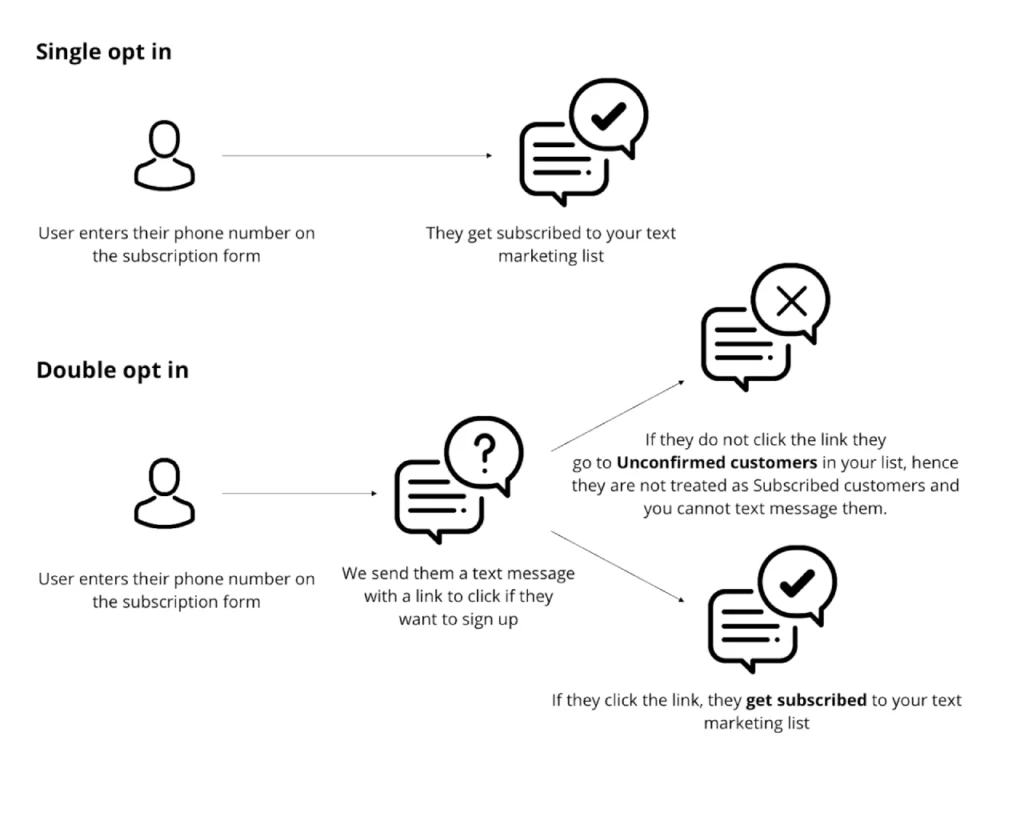
- Use clear consent language: Ensure your opt-in copy clearly explains what subscribers are signing up for and complies with TCPA regulations.
- Disclose message frequency: Be transparent about how often subscribers can expect to hear from you.
- Simplify the Opt-Out Process: Make unsubscribing easy by including clear STOP instructions in every message.
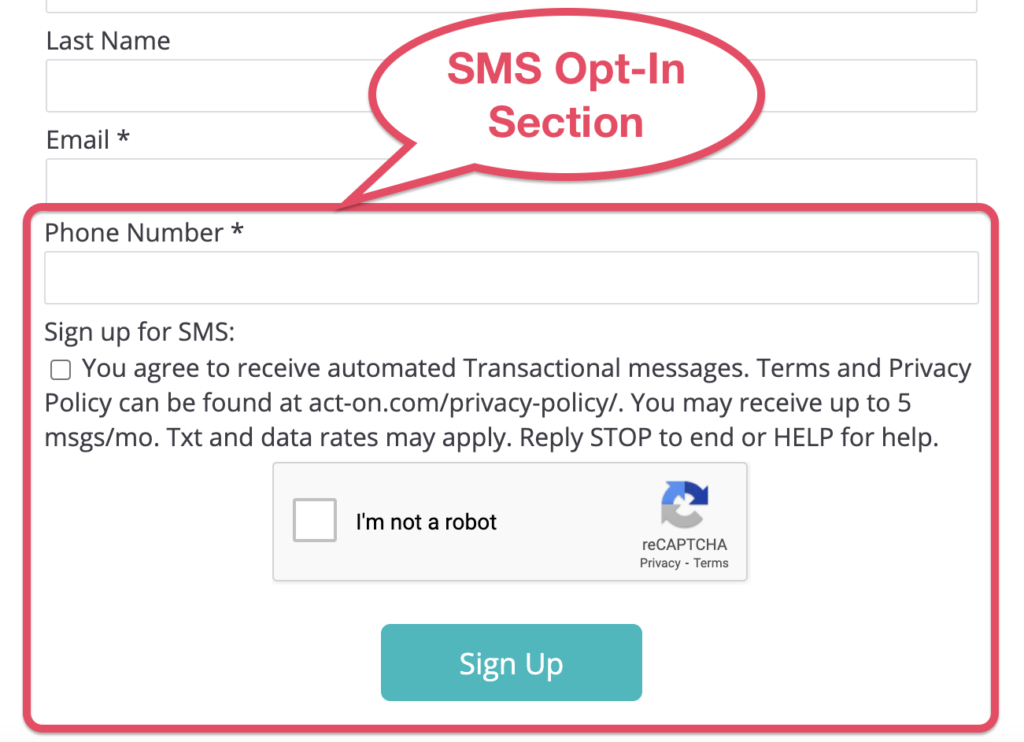
Actively manage and monitor your list
- Update segments regularly: Continuously refine your subscriber segments based on behavior, purchase history, or engagement level. Here’s how to adjust them based on customer actions:
| Segment Type | Update Trigger | Action to Take |
|---|---|---|
| Recent Purchasers | Customer places a new order | Move from “Prospect” to “Active Buyer” segment |
| Abandoned Cart Users | Added items to cart but didn’t complete purchase | Add to “Cart Abandoner” segment for follow-up |
| Inactive Subscribers | No clicks or replies in last 45+ days | Flag as inactive or move to “Re-engagement” list |
| Frequent Buyers | 3+ purchases within the last 60 days | Add to VIP or Loyalty segment |
| Newsletter Subscribers | Engaged with emails but not SMS | Target with SMS opt-in incentive campaign |
| Location-Based Groups | Based on shipping address or IP geolocation | Group by region for local promos or updates |
- Monitor engagement: Track key metrics like open rates, clicks, and reply rates to spot declining interest early.
- Offer preference management: Let subscribers choose how often they receive messages, or what types of updates they prefer.
- Document compliance: Maintain detailed records of opt-ins, opt-outs, and list cleaning actions to stay audit-ready.
Read Next: SMS Marketing Analytics: 10 SMS Metrics You Cannot Ignore
Re-engage subscribers before you lose them
- Run win-back campaigns: Send personalized offers to re-engage dormant or inactive subscribers. Here are a few proven win-back ideas based on different subscriber types:
| Subscriber Type | Trigger | Offer Idea |
|---|---|---|
| 30-day inactive | No engagement for 30+ days | 10% off on your next order |
| Cart abandoners (cold) | Abandoned cart over 2 weeks ago | Free shipping + reminder |
| Previous buyers (3+ mo) | No purchase in 90+ days | BOGO or limited-time discount |
| Low engagement segment | No clicks/opens in the past 3 campaigns | Early access to a sale or product drop |
| Referral lapsed users | Referred by a friend but never purchased | Flash discount + referral bonus |
- Prompt for preference updates: Ask inactive users if they’d like to adjust the frequency or type of messages they receive.
- Collect feedback: Use SMS to ask why subscribers may have disengaged—then adjust based on insights.
- Offer alternate channels: If SMS no longer suits their preference, suggest switching to email or following on social media.
P.S. TxtCart’s AI-driven insights and automations help craft targeted messages and optimize re-engagement campaigns for maximum engagement. Its smart automation ensures timely, relevant responses—boosting customer retention effortlessly.
Joyride, an LA-based dog harness brand, leveraged TxtCart’s 2-way SMS to generate $1,841,617 in revenue, with 23,616 sales generated and over 2.8M customer conversations, driving massive growth in their eCommerce operations.
$1,841,617
SMS Attributed Revenue
12.4x
SMS Attributed ROI
23,616
Sales Generated
“Kyle and the team at TxtCart have been instrumental in our growth. They’ve worked closely with us to create custom solutions and the results have been phenomenal. TxtCart has helped us scale significantly and provided support at every turn.“
Founder, Joyride
Read Next: SMS Win-Back Campaigns: Tips to Earn Thousands in Revenue
Turn Your SMS List Hygiene Into Sales With TxtCart
No matter where your Shopify store stands today, keeping your SMS list clean is essential to staying connected with customers who actually want to hear from you. Feeling overwhelmed? Don’t worry, TxtCart simplifies everything. With smart automation and live eCommerce agents, we help you grow, clean, and convert your SMS list—all at once.
Ready to make your SMS list work harder for your store?
Want to try conversational SMS for free?
- Try free for 14 days
- 10x ROI guaranteed
